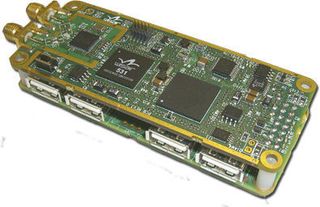Ultra-wideband USB hubs make waves at Computex
Taipei (Taiwan) - About a year and a half ago, Intel and others started making news with the introduction of a wireless signaling technology called Ultra Wideband (UWB). The idea was to claim a broad, 500 MHz-wide swath of the radio spectrum at extremely high frequencies (between 3.1 and 10.6 GHz), for use by very low-power transmitters. These transmitters would send data along multiple channels within this half-gigahertz range simultaneously, for a transmission rate in the range hundreds of megabytes per second. This technology has gained ground rapidly; and already at Computex today, vendors are announcing what they call the "second wave" of UWB components geared as wireless USB hubs.

An ultra-wideband (UWB) USB hub based on Wisair's reference design. (Courtesy Wisair)
Both Iogear and Wisair are showing UWB wireless USB hub technology which they claim will be capable of transmitting up to 480 Mbps, enabling up to four simultaneous wireless connections to such high-bandwidth devices as printers, scanners, and external hard drives. The setup is not entirely wireless: Peripherals are attached to the UWB hub by ordinary USB cables, though the hub connects to a notebook computer through a pre-paired USB adapter dongle.
What's interesting is that here, too, we're finding two conflicting standards, the differences between which may lie in implementation: Iogear's UWB Hub & Adapter Kit boasts of a transmission range of up to 30 feet, using a technology called Multiband Orthogonal Frequency Division Multiplexing (MB-OFPM) supported by the WiMedia Alliance - which is backed by powerhouses Intel and Philips - and adopted as an international standard by ECMA. Meanwhile, Wisair is demonstrating its chipset for what it's calling "second-generation" Certified Wireless USB, which takes the WiMedia Alliance's same technology and transmission rate, but boosts the distance up to 100 feet. Today, Wisair announced it is demonstrating a reference design for its chipset at Computex, featuring a transmission of high-definition video over UWB, at a distance of 100 feet.
How soon we'll see hub products based on Wisair's chipset is unknown, but at this rate, it could only be a matter of a few months, if not weeks.
The WiMedia push comes amid competition from a competing group called the UWB Forum, whose membership includes Agilent, Belkin, Flextronics, Lucent, Pinpoint, Siemens, Tektronix, and Via Technologies. In April, after Bluetooth picked the WiMedia Alliance to help it build a next-generation successor to its current wireless transmission standard, prominent members Motorola and Freescale Semiconductor left the UWB Forum. This after the UWB Forum and the WiMedia Alliance issued a joint press release back in January stating the two sides had agreed to let the market decide which standard is the ultimate victor, and to abide by the market's decision. Observers note that Motorola appears to be going forward with its own CableFree 2.0 specification, in defiance of both industry groups. Motorola has made some announcements this morning, but only regarding its new RAZR V3m smart phone, not about CableFree.
Meanwhile, smaller companies such as Taiwanese manufacturer E-Top Network Technology are finding themselves premiering USB wireless routers at Computex like the Navi 210WV without UWB, with transmission speeds limited to a mere 54 Mbps. It may take some steep discounts for companies like these to keep their new, though suddenly underperforming, equipment performing well in a suddenly crowded marketplace.
Stay on the Cutting Edge
Join the experts who read Tom's Hardware for the inside track on enthusiast PC tech news — and have for over 25 years. We'll send breaking news and in-depth reviews of CPUs, GPUs, AI, maker hardware and more straight to your inbox.
Most Popular


